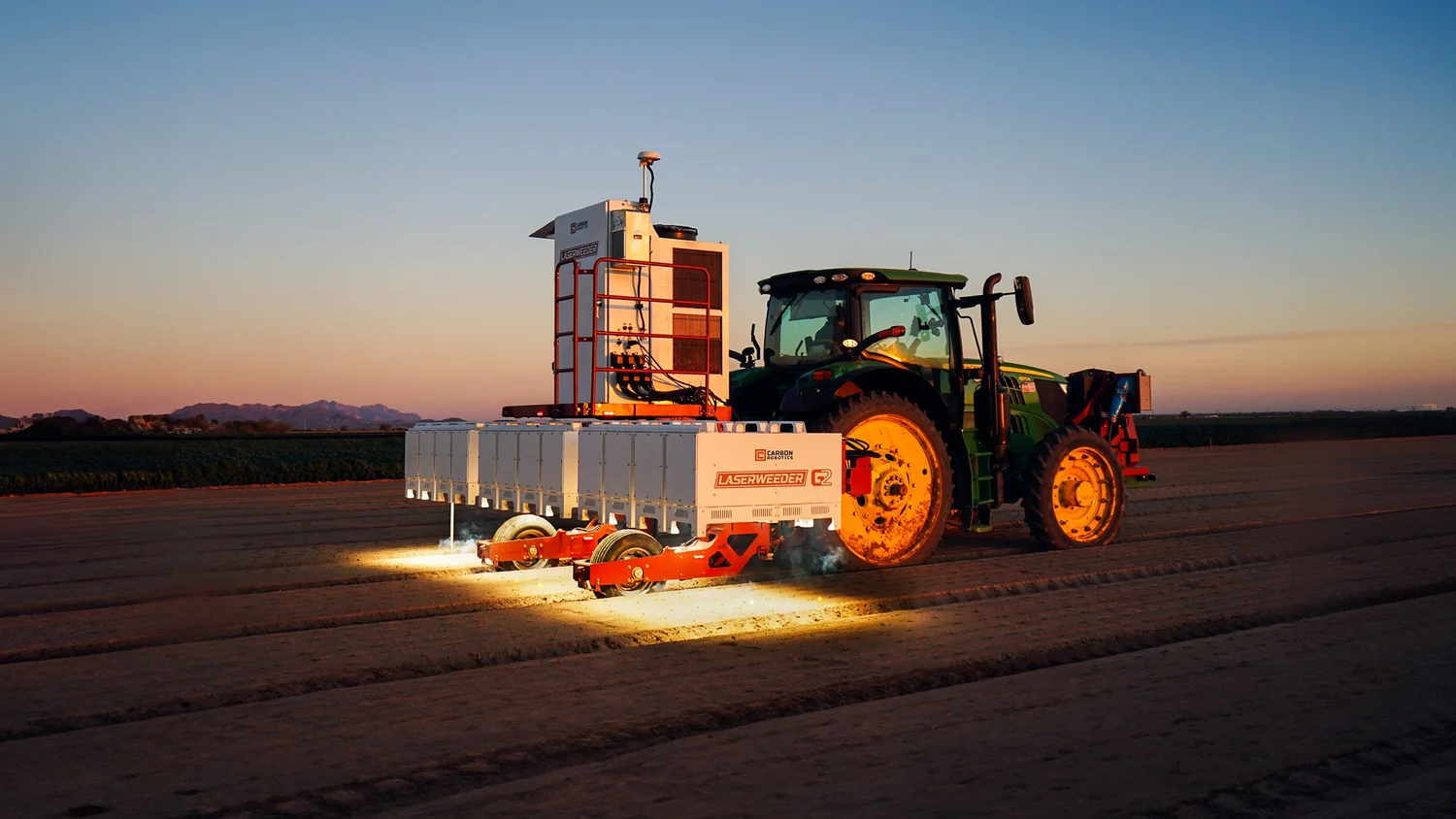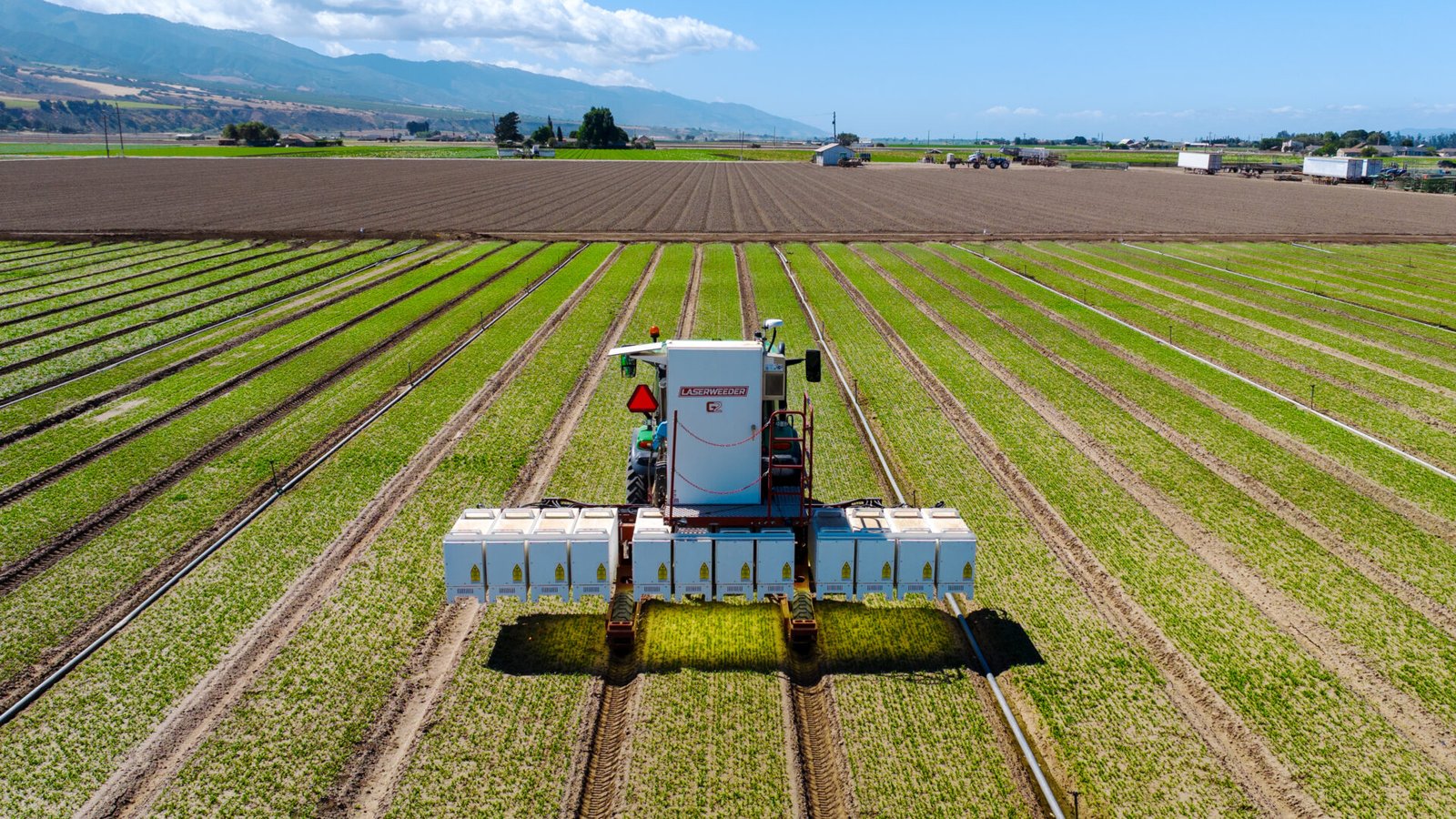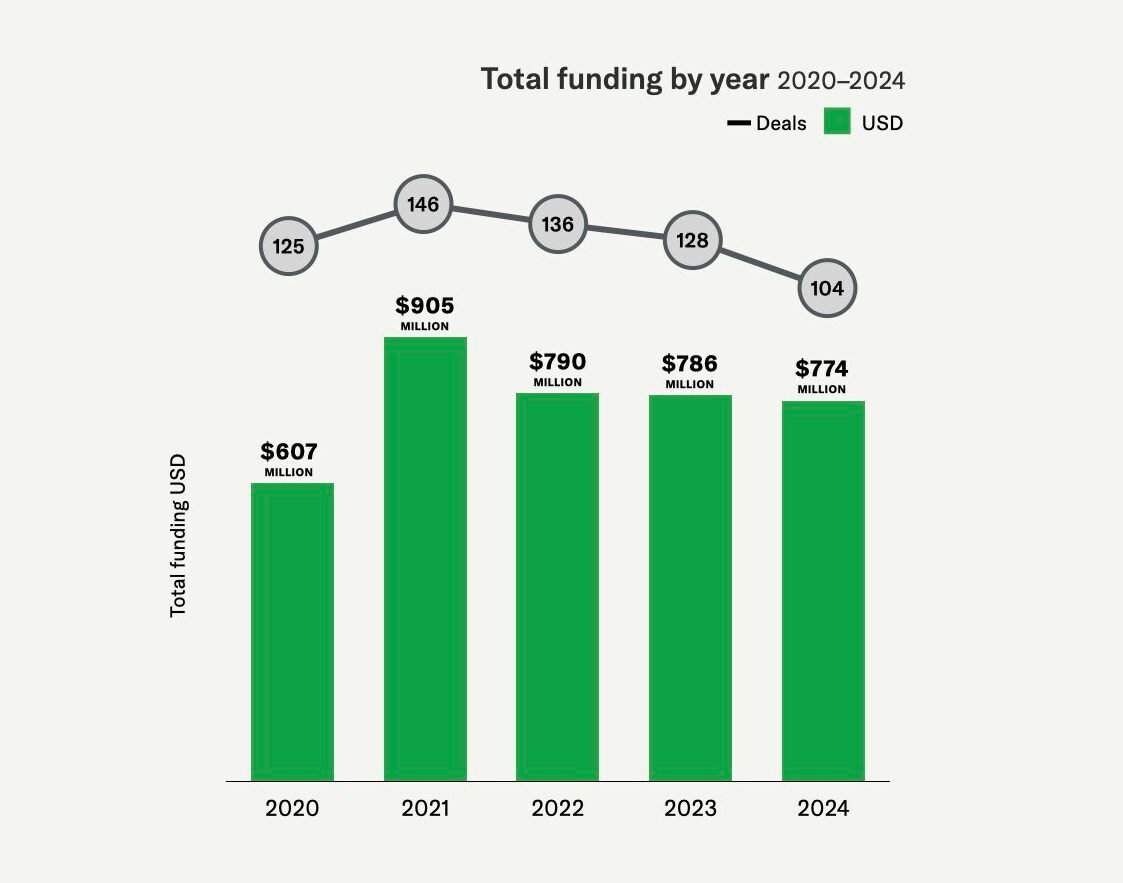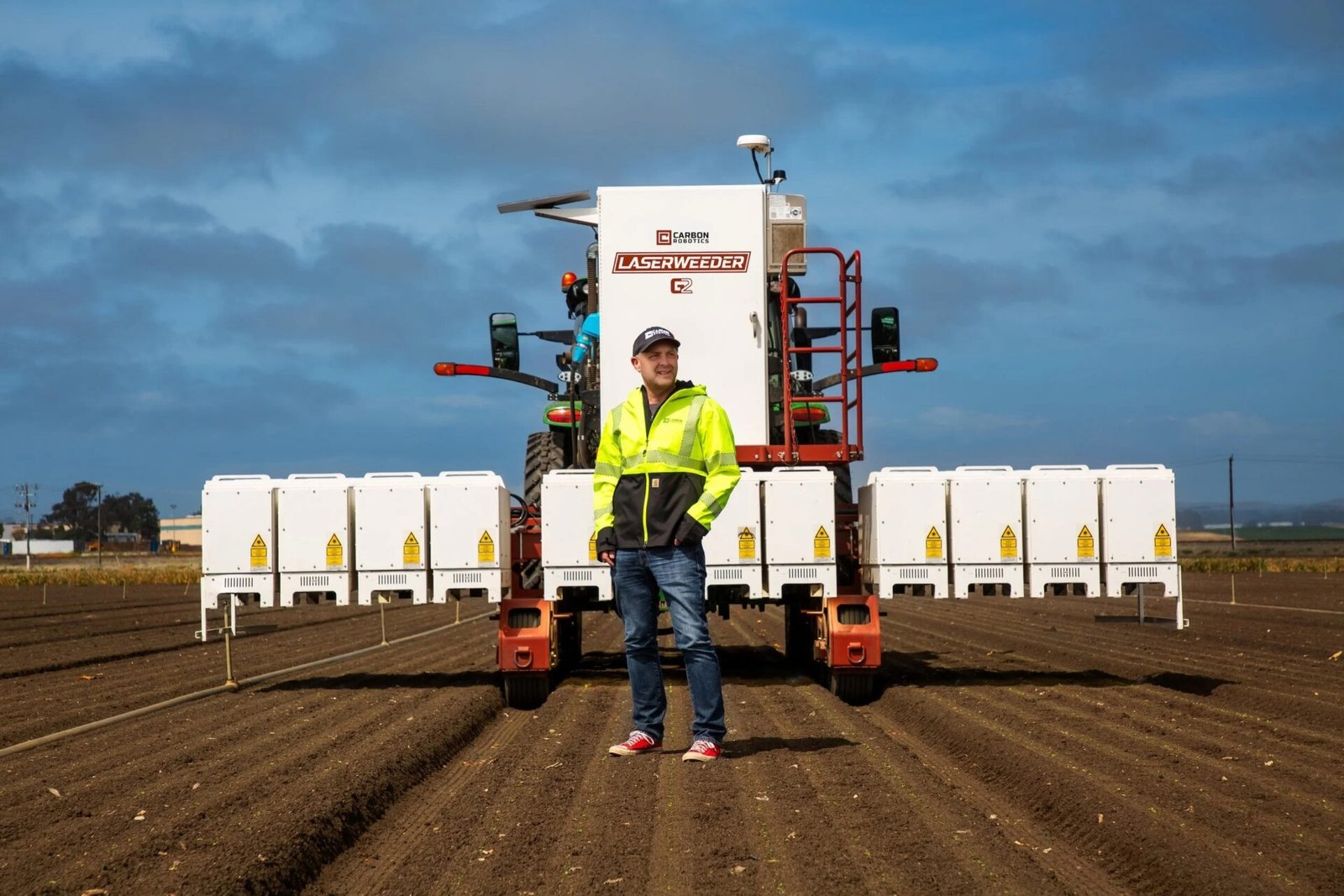Will ag automation and robotics ever reach smaller farms? Will specialty crops ever see the rise of harvesting robots? And most important, how should agtech startups approach VCs now that the cheap money is gone and investment is down?
In a whirlwind interview, AgFunderNews covered all of this and more with Paul Mikesell, founder and CEO of Carbon Robotics, a company best known for its autonomous LaserWeeder for agriculture.
The chat came on the heels of the company’s $20 million D-2 extension round led by Giant Ventures. According to Mikesell, the round will go towards “another AI robot” in the works, though further details are under wraps for now.
In the meantime, Mikesell offered up thoughts on harvest robots, working with ag dealerships (or not), and how agtech startups should talk about themselves.
AgFunderNews (AFN): First thing’s first, where will the new funding go?
Paul Mikesell (PM): We’re targeting it very specifically towards a product that we’re working on, something not yet announced and, of course, not yet released. It is a completely separate project from LaserWeeder. I’ll call it a targeted incisive bet we’re making to build something.
There’s another AI robot that reuses our existing artificial intelligence technology to do some more interesting work for farmers. So we’re investing heavily into this product and the round is specifically for that.
AFN: Weeding is still the most popular farm task to automate. Why don’t we see these technologies successfully applied to other areas as much?
PM: Part of it is that with weed control, you can kill weeds in carrots and onions and broccoli and cauliflower and lettuce and spinach [with the same machine]. Versus say a harvesting robot that would be very specific to those crops. So it’s the repeatability of the task across a broad range of crop types. That’s one of the advantages that weed can control has.
In sorting and grading, there’s lots of computer vision-based tech in that space. Some of those companies are really good at it. Some of them aren’t. I think there’s opportunities there for somebody to come along with some better technology.
There’s been a pretty exciting new crop of companies doing UV for pest control, and you’re able to do things in a bunch of different crops with this same technology.
I think everybody still looking for what to do on the harvest side. I know some of the big growers really want harvesting robots. That’s a challenge until we get to the point that somebody figures out a more general-purpose way of doing it, because [the machines] are so specific.
So it may be more that the harvesting side is hard, not necessarily that weed control is excessively easy.

AFN: Will we see these automation and robotics technologies trickle down into smaller farming operations or are they mostly for the big ones?
PM: We had our G2, or generation two LaserWeeder, come out in February of this year, and we do have smaller machines. We have a six-foot machine now that has been really successful in some of those smaller farms. For things even smaller still, that’s a constant investigation of ours. We may produce something along those lines at some point—like a really, really small robot.
As a company, you have to make sure that your balance sheet is right, and so unfortunately that means that the smaller machines wind up coming out later in the product life cycle. And that’s kind of just the reality of doing business.
But we’re getting there, and we’re moving quick enough now that we do have the six-foot machines, which is just a single, 80-inch row. For farms even smaller than that, we might potentially come out with something. It would still use the G2 technology, because the G2 is a modular architecture, and we would just make something that was maybe a one or two module, but that’s TBD.
AFN: Would super-small farms even pay for automation?
PM: It’s really about ROI. If the machine pays for itself, (our machines pay for themselves between one to three years), then it’s really just about right-sizing the machine for the operation.
There are farms that are 50 acres and running our little machine that are happy with it. They’re getting profit out of it. So we’re getting down there now.
If you’re thinking about a much smaller farm, a 10-acre situation, that would be a smaller machine, because even a six-foot machine would clear [a field out] and you wouldn’t have enough opportunity to get the value, to make the ROI.
It was part of the motivation behind the G2: the modularity allowing us to do those kinds of things.

AFN: How does Carbon Robotics approach customer relationships? Do you go through a dealer?
PM: It’s always direct. We do help with financing. We have banking partners in the United States and in Europe who will help finance the machines, or a farmer if they want.
We don’t use dealerships. I haven’t found a dealership network that would really be able to give us anything, and I like having the direct relationship with the customer so that they know the company, they know the sales person, they know the support team, they know me.
I think that’s better than going through a dealership, because there’s always something kind of lost in translation there. And it’s also because the technology is a lot of optics and lasers and computers. It’s the kind of thing where we really need to service it [ourselves] anyway. I’m not gonna be able to train, say, the local farm dealership, the tractor dealership, on how to how to do this kind of maintenance and repair. So there’s not really any advantage for the farmer there.
AFN: Has that caused any challenges in trying to scale the business?
PM: In other businesses and other industries, we would refer to this as “the channel” or “channel partnership.” I think that the agriculture channel opportunity is just not there.
I can’t even think of examples of early or even medium-stage agtech companies that started selling through dealerships and it was helpful to them.
For us, we just scale out the sales rep team. I have a sales team throughout the United States, all throughout Europe and Australia. I don’t have a lot of challenges reaching people. It’s a load on our travel budget, but other than that, we’re able to get to people.
I can’t see any existing dealership network that I could even imagine being a channel help for us. And most of the time, farm activity has been focused on kind of purchasing the same tools over for the last 50, 60 years. None of these channels are set to accept any new products or technology. They don’t know how to learn about it, talk about benefits, know when to introduce it in a customer relationship. That may be a muscle that is built in other industries that just doesn’t really exist in agriculture.
I have a couple of examples—I cannot say names—of companies who signed these dealership agreements and weren’t perhaps savvy enough about what it meant. They wound up signing exclusive territory agreements and basically locked themselves out of their own market. They weren’t allowed to sell because it was dealership only, and then the dealer didn’t do anything. The revenue just for that area just disappeared.
So if you’re going to sign a contract like that, you also have to be very careful about what you’re signing up for. In this space, at least, people get kind of starry eyed about what a dealership may do for them, and aren’t careful enough thinking about what the downsides could be. I would caution people, if you have an agtech company, to be very careful about the terms of any dealer distribution contract.

AFN: What other advice can you offer agtech startups, particularly in this tough funding environment?
PM: The funding is there. You have to prove the business model, the ROI, and provide enough value, and then get your customers to be able to talk about it.
Starting Carbon Robotics, I had the benefit of having done that in other industries and so I was pretty comfortable with what the VCs want to see, and I know how to build the funding case for them.
But the other thing about this area right now is you have to be careful how you talk about it. You need to position yourself correctly. For us, we’re an “AI robotics company.” Because if you come to a funding source, a venture capitalist, and you start talking about agriculture, most of the time they don’t know what you’re talking about. Worst case scenario, they’re going to be disinterested; at best they’ll be confused.
So you need to talk about why your product and technology is interesting and capable of acceleration into market scale and profitability in a way that makes sense to venture capitalists.
Some of this is just about storytelling. How do you frame things?
Getting your customers to speak for you, I think, is the number one thing that has worked well for me—not just in agriculture, but across probably all of my companies. If you’re a founder trying to start an agtech startup, get those customer-tested testimonials. Even if you’re pre product, get somebody, a group of people, to say, “If I had this, I would buy it.”
If you can’t get customers to say that to a VC, then you need to think about what you’re doing.
If you’re going to start a fire, you need to start with some kind of kindling. And that was the number one kindling to get things going, to just get get people who can talk about.

AFN: What’s next on the horizon for Carbon Robotics?
PM: We’re scaling and growing the AI team and the engineering team to work on, let’s call it “project three” for you. That’s probably the most exciting stuff happening.
We’ve been expanding our manufacturing capacity. We took our manufacturing in house, so we’re doing the manufacturing of our own machines now. That’s been very successful for us. Margin went way up on products, and a lot of this is because when you’re paying a [third-party] contract manufacturer, they take margin. Now, we control the whole process. Now that [money] goes to the employees and we can take a little bit of extra margin. The only reason we didn’t do this from the beginning is just scale.
Now we’ve stood up a manufacturing line in the Netherlands so that we can serve our European customers locally. Unfortunately, we got pushed into doing that quicker than we otherwise may have because of the tariffs.
That whole situation was not great, but it accelerated our plans to manufacture into Europe, and has been great. We have an excellent team over there, so I’m happy about that, and it just sort of diversifies our production capabilities.
AFN: Will we ever see Carbon Robotics expand beyond agriculture?
PM: I’m sure that will happen, because all of our products in agriculture really rely on our AI systems and computer vision. These neural networks essentially do the world building inside the AI. So what we’re doing is understanding the world around the machine and then taking action in that word. That’s what the LaserWeeder does. That’s what the autonomous tractor kit does. And that’s applicable to many other things.
Agriculture for us started out as just a really interesting space, and I saw the ways in which we could help, and I’ve come to really love the industry. But I do think the technology can go into other areas, and we will be investigating some of those, because this same system would be applicable to many, to many different places. At some point that would help us balance out the cyclical nature of farming.
The post Carbon Robotics founder Paul Mikesell on agtech: ‘Be careful how you talk about it’ appeared first on AgFunderNews.














